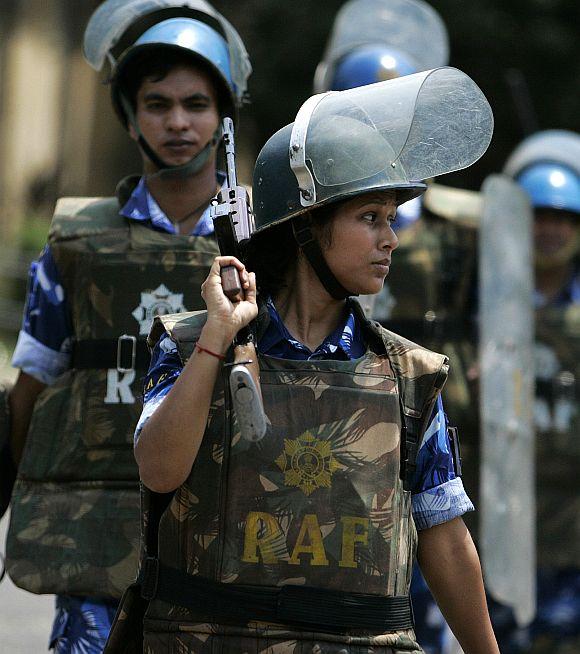
The notion that women are not suited to combat duty is changing. They are excelling in security roles across the country, reports Veenu Sandhu.
In October 1986, I received a letter from Rajiv Gandhi. The postman was flummoxed. Why had the prime minister written to a 13-year-old? Gandhi had replied to my letter that asked him why India couldn't have a combat battalion of women in the army. At that time, women were found only in the nursing and medical wings of the army. "It seems I have been getting a spate of letters recently from girls, all wanting to join the Army. A fighting force is no place for young ladies for many reasons," Gandhi said in the letter.
"There is no lack of man power (sic) for deployment to border areas. On the other hand, if women marched off to the frontiers, menfolk would find themselves hopelessly at a loss defending hearths and homes!" Read letter here
A lot has changed in the last three decades. Women have become part of practically every layer of security which the country requires. They have brought down intruders at borders, patrolled villages in the Naxal-affected areas of central India, provided security cover at the highest level, and been on commando duty at high-security public places like the Delhi Metro and the Delhi airport. They make formidable bouncers at nightclubs and are used as bodyguards in large numbers.
Ranjita Ganesan in Mumbai contributed to this article
Please …
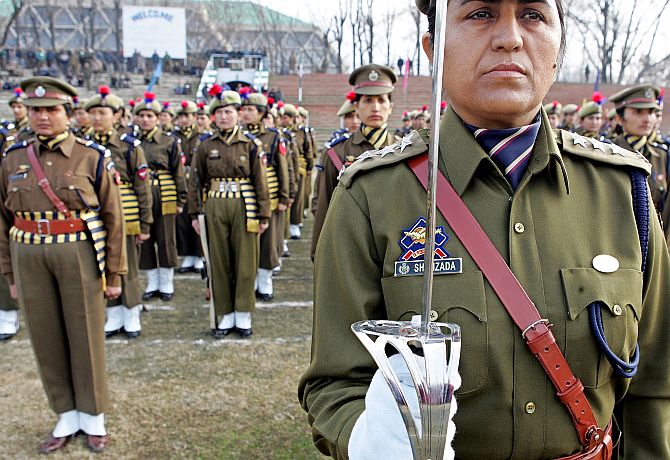
The arrival of Prime Minister Manmohan Singh's wife, Gursharan Kaur, at a function organised by the Border Security Force last month caused a rare flurry of excitement. Seen in her immediate security cordon were women commandos of the Special Protection Group. Drawn from the Central Industrial Security Force, which has about 5,550 women in its ranks, they had undergone three months of rigorous training at the SPG Complex in Sector 8, Dwarka in southwest Delhi.
At the closely-guarded SPG complex, which even has a firing range inside, new entrants are moulded within 90 days to have lightning-fast responses, an eagle eye and an ability to take split-second decisions. "SPG takes the training to a whole new level. There is immense emphasis on stamina and unarmed combat," says a woman commando who was part of SPG for several years. Physically, you come out rock solid. And mentally, you emerge as a remarkable combination of a great team player and a fiercely independent thinker, she says.
Guarding Kaur is not a random assignment for the women. "You will always find women SPG personnel deployed at Sonia and Priyanka Gandhi's election rallies," says a woman commando. "You might not see them immediately around them -- that space is occupied by male SPG commandos -- but they are always there, silent and alert."
About 2,500 km from Delhi, at the residence of Manipur Chief Minister Ibobi Singh, it's women commandos of CISF who keep a close watch on visitors queuing up to meet Singh and his MLA wife, Landhoni Devi, springing into action at the slightest suspicion.
There is also talk of women commandos being deployed in the security ring of Bharatiya Janata Party's prime ministerial candidate, Narendra Modi. In Punjab, Deputy Chief Minister Sukhbir Badal has women as his personal security officers.
Please …
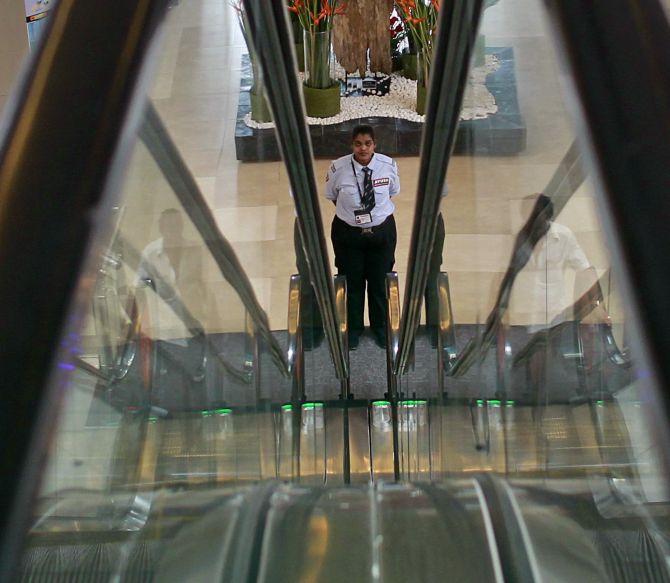
Sharayu Bhatia, a lady bouncer at a five-star hotel in Mumbai, cuts an imposing figure even while seated. The 42-year-old is tall and well-built, dressed in a black safari suit, her hair swept back in a slick bun. The sternness of her appearance is softened only by a pair of golden earrings and the red dot she wears on her forehead. At the smallest hint of unrest, she and other lady bouncers jump into action.
Bhatia works for TopsGrup, a private security agency, and is trained for any contingency. Sakina, her colleague, recalls the time when she and other lady bouncers had whisked away executives of a company after they were surrounded by about 1,500 irate workers in Thane.
"An angry mob will not go easy just because there is a woman bouncer warding it off," she says. "It will attack with the same fury."
Five TopsGrup bouncers were deployed at strategic locations during Sachin Tendulkar's farewell match at Mumbai's Wankhede Stadium last month.
Megha Ahlawat (name changed), who works as a bouncer at a night club in Gurgaon, looks like a commando. Her eyes dart from corner to corner. For a burly woman, she moves like a cat.
Dressed in black jeans and a black sweatshirt with "security" written on it, she makes sure no one misbehaves. As she spots a youngster getting overbearing with a lady, she politely, but firmly, escorts him out. He dare not challenge her. "I have about 300 women bouncers and could do with 70 more. The demand was skyrocketed," says Rajesh Sharma of Faridabad-based Armour Protection and Facility Management.
These are strong, tall girls from Haryana and Punjab. Some are bouncers-cum-drivers who are in big demand with call centres where women work night shifts. Some are responsible for the personal security of wives and daughters of bureaucrats and businessmen.
They shadow the ladies to the market, college, kitty party and club. The brief to them is clear: do not lose your temper and do not hit even if provoked. "That's because they can knock out even a man if they decide to," says Sharma. The women earn Rs 15,000-18,000 a month for a 12-hour shift.
Please …

For the women of the Central Reserve Police Force, there are no such shifts. They are on duty 24x7. At the headquarters of CRPF's 88 Mahila Battalion -- the world's first armed women paramilitary battalion -- in Delhi's Dwarka, 17 women are back from duty in the Naxal hotbed of Jagdalpur in Chhattisgarh's Bastar district. The oldest among them, Gurubari Devi, is 46.
The youngest, Priyanka Pratap, is 22. The campus is sprawling with women in uniform, some of them in fatigues. The handful of male jawans salute the women officers with a spontaneous "Jai Hind Sa'ab".
It's 10.30 am. In the open ground behind the barracks, one batch is undergoing weapon training. The rest are done with the early morning exercises that include rope-climbing, monkey crawling and running.
Besides patrolling, area dominance and search operations, the job of the women who served in Jagdalpur was to win the trust of the villagers living in remote areas deep in the forest. The Naxals have a strong woman cadre. The security forces can counter them with one of their own.
"We were required to proceed slowly, comb and search the route with metal detectors and adopt a zigzag formation to escape being hit in case of an attack," says Sunita Hansdah, a constable. "In the villages, it is evident that people are really scared of the uniform, though they find it slightly easier to open up with women," recalls her colleague, Rashmi Jatwar.
The women look tough in their fatigues. But their features soften as they smile. Their presence, say their senior officers, proved effective in establishing links with the locals.
Please …
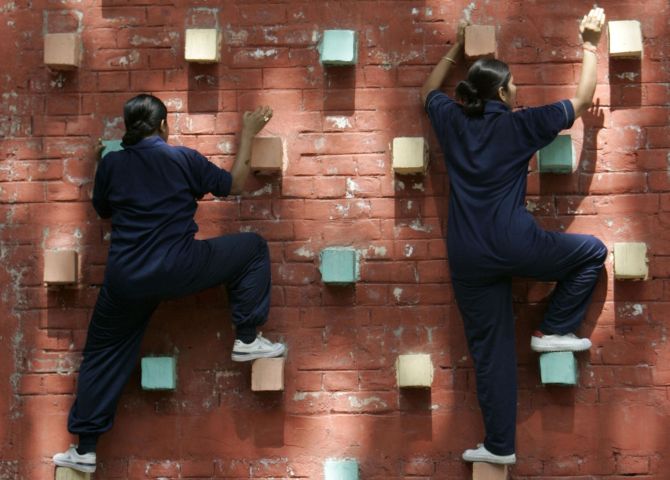
Meanwhile, the second batch of 30 women CRPF commandos is being trained at Jodhpur for anti-terror operations and to tackle civilian hostage crises. The training is the same as what the male commandos undergo. "There can be no compromise on operations requirements. The terrorist will take on a woman commando as he would a male," says AP Maheshwari, inspector general (Northern Range), CRPF.
At Sher-I-Kashmir Police Academy in Udhampur, too, the first batch of about 80 women commandos has passed out after nine months of rigorous training.
And, deep in the forests of Gir in Gujarat, about 40 women guards are out patrolling every day, either on foot or on motorbikes, an eye out for smugglers and poachers. Armed with guns and walkie-talkies, some of them have had unfriendly encounters with lions and have scars to prove that. But, besides the scars, they also have victories to talk of, like the time when an all-woman team caught a gang of poachers.
Slithering through the mass of humanity at the Rajiv Chowk Metro station in Delhi are four combat-ready women of CISF's quick response team. Dressed in fatigues and armed with guns, they cut an impressive figure. The commuters turn to take a second look, though no one dares to get friendly with them.
Work at the Metro stations is not easy given the sheer traffic that tumbles in and out of the busy junction. Having combed the area a few times, 27-year-old Sub-Inspector Rinki Chauhan leads her team of commandos to a vantage point from where they watch the passengers for any suspicious behaviour.
This is the visible face of security at the Delhi Metro. "There is also the invisible face - the Crime Intelligence Wing, or CIW. Women of this wing are dressed like passengers and they mingle with them, studying them, taking mental notes and reacting in seconds if the need arises," says Deputy Inspector General (Delhi Metro) Udayan Banerjee.
CIW personnel Monica Borgohain, a bubbly young girl in jeans and a sweater, could pass off as a college student. But she knows the pickpockets by their look and can instantly identify if a commuter can cause trouble. In all, Delhi Metro has over 800 women keeping it secure.
Please …
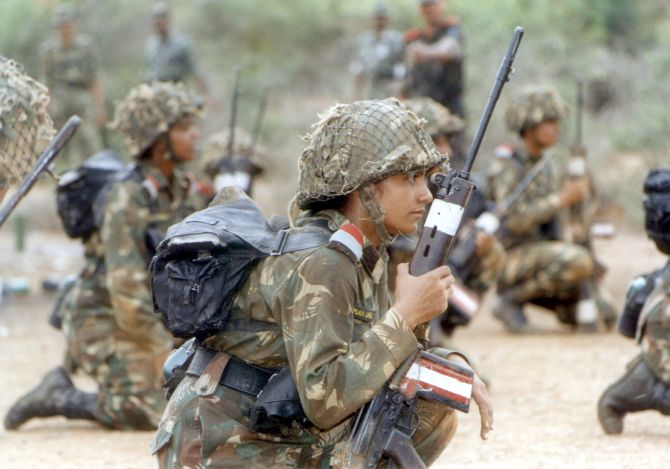
Far away from bustling Delhi, right next to the barbed fence which separates India and Pakistan, are the patrol teams of tall and fit women of the Border Security Force. Armed with AK-47s, they were initially deployed at the border to frisk suspected women drug couriers. Now, their duties have moved beyond frisking.
Last year in May, two of them -- Arti Kaur and Rina Kaur of 74 Battalion -- shot dead a Pakistani intruder at the Punjab border. They spotted the man trying to cross the fence and warned him.
He ignored them and tried to take cover in the wheat fields. The constables chased him for about 300 metres, warning him again. When he didn't stop, the women opened fired, killing him on the spot.
The incident left the BSF looking at its women force with new pride. This year, for the first time, the force has decided to recruit 14 women officers. Until now, it had only lady constables and sub-inspectors.
The Indian Army, the final frontier, also has a sizeable number of woman working in different roles now. They are deployed close to the border with Pakistan and China. "But not at the border, not yet. That space is occupied by the infantry," says a lady officer of the rank of major who is posted in Kashmir and has served in the army for seven years.
"Women are still not recruited to combat arms like the infantry, armoured corps and the artillery," she says. And, they are allowed entry only at officer level -- jawans and the other ranks up to junior commissioned officers are open only to men.
While women in the paramilitary assert that they are treated completely at par with their male counterparts, a lady army officer says, "As women, we have to work harder and prove ourselves to win the respect of the male officers." Even so, she adds, "women are getting challenging field postings in remote areas of the Valley and the Northeast."
Compared to the US, Israel and Australia which send women to the war zones -- American and Australian women soldiers are also on combat duties in Afghanistan -- the Indian Army still has some ground to cover on this front. "It's a policy decision," says a senior army official. "Things could change in the future, but I cannot say how long that might take."
In the Air Force, women now get to fly twin-engine helicopters such as the Mi-8 and Mi-17. The next step could be full-bodied assault helicopters, the Mi-25 and Mi-35. But flying a fighter plane remains a dream. In this respect, Pakistan Air Force has taken the lead. It now has a war-ready woman fighter pilot -- 26-year-old Ayesha Farooq. Pakistan also has five other women fighter pilots waiting in the wings to take the final tests to qualify for combat.
In India, by contrast, the views Rajiv Gandhi expressed in his letter still seem to hold true.
...